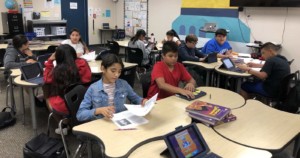6 Creative Ways to Revamp PD in 2018

By Amy Jenkins, COO, and Kelly Freiheit, Senior Design Principal, at Education Elements
In a recent meeting with a small group of teachers we asked them about the professional development at their school. Each teacher glanced around at the others, unsure what to say. With a nervous laugh, one said “Ummm. It’s not that effective?” And the floodgates opened. A series of adjectives and descriptions followed, with teachers calling it boring, saying it was unactionable, and lamenting that they spent most of their time in professional development sessions wanting it to be over. It sounded familiar.
The irony is not lost on us that school districts across the country are changing learning experiences for students without changing how they are training their teachers, so our approach to professional development is different. We aim to make PD fun, design our PD sessions to model ways we would like teachers to teach, and provide choice about what and how leaders and teachers learn. We do our best to make it memorable and actionable. What have we found that works? Here are just a few ways:
Passion Projects
Through our work at Belmont Station Elementary School in Loudoun County Public Schools, the leadership team created Passion Projects that hone in on a driving question for the school year. In doing so, they wanted to model a way to support students’ interest, while also creating more excitement for the teachers. The team dedicated time during their staff meetings to explore and learn from each other’s Passion Projects, where teachers had an opportunity to share their learnings with staff members along their journey. Some teachers explored brain breaks to giving students choice during morning work. Join in on the excitement!
Wow!!! So impressed with our @BSTElementary teachers for sharing their Passion Project about adding choice to Morning Work and #makingyourmorningsmatter #geniushour #lcps18 pic.twitter.com/e0j7OPxxPf
— Hollie Wilee (@HollieWilee) January 25, 2018
The BeST PE teacher shares his #passionproject on the importance of incorporating #brainbreaks throughout the day #lcps18 #geniushour pic.twitter.com/UUAzdb06Hq
— Hollie Wilee (@HollieWilee) January 25, 2018
Playlists
We worked with Hartford Public Schools to co-develop ongoing professional development by utilizing a playlist that includes articles, videos, and various artifacts for teachers to explore. Teachers could go at their own pace, select what they wanted to learn and see how playlists could be used in their classrooms. In year two of the implementation, one of the high schools in Hartford has decided to include an incentive by using Paw Points. These points are collected and displayed outside of teacher’s doors. As teachers complete their playlist, they share their reflections on their school’s Google+ Community.
Coffee & Conversation Sessions
In the Enlarged City School District of Middletown, New York and Loudoun County Public Schools, Virginia principals are hosting Coffee & Conversation Sessions to cover questions, answers, or conversation on teacher-choice topics. Topics range from “what is personalized learning” to “how to lead student-led conferences.” As a result, principals are seeing the shift in teachers taking ownership of their professional development – who like both the coffee and the caffeine. It also led them to think about how they could conference with students and parents differently.
Excited to kick off our PD day w/School wide PL Pep Talk! Breakfast, Skyping w/mystery guest, & PL. Want to join us @nslev116? #jmlpride pic.twitter.com/elT11HkvnE
— Michelle Schwartz (@HRM_IFT) October 20, 2017
Pineapple Charts
Did you know the pineapple symbolizes “welcome?” Many schools across the country are implementing the Pineapple Chart to encourage teachers to open their classrooms to other teachers. We’ve learned from our experience in districts that the number one request from teachers is, “I want to see an example of this working in my district.” It’s been most successful in schools where teachers sign-up voluntarily and post a pineapple outside of their door. One school in Virginia has taken it to the next level by color coding their pineapples. For instance, green stands for “I am confident in my implementation today,” yellow stands for, “I’m trying something new today and it might not be perfect,” and red stands for “you’re welcome in my classroom today but my kids might be testing, etc.” The Pineapple Chart not only builds excitement but also taps into building the capacity within a school and district.
Here it is….#Ellington's #pineapplechart So excited for this staff to share their skills with one another. #TransformCCSD pic.twitter.com/BGONodvyzm
— Summer Pettigrew, NBCT 📚📐🔍 (@summerpettigrew) December 15, 2017
 Self Reflections
Self Reflections
Instructional leaders are utilizing self-reflection as one way to tap into what teachers want. We’ve seen the Core Four Continuum used as a way to define the current state in a single-classroom and a whole-school. From these reflections, instructional leaders are able to personalize the professional development from 1:1 support to whole group support digging deep into the core areas of the Core Four. Teachers are no longer sitting in professional development that is not relatable to them, but instead leaders are able to reach them where they are.
Badging
And to show progress? In some districts, teachers or schools can earn badges to display, letting everyone know what they’ve learned and how far they have come. Horry County Schools has implemented a badging system district-wide. See the energy of badging by checking out #HCSBadges on Twitter.
Each of these approaches to learning would be considered non-traditional and a far improvement from the sit-and-look-at-your-watch PD that teachers often describe – and we can’t imagine why we would do it any other way. If we want learning experiences to change for students, we have to change them for teachers too.
For more, see:
- Unlearn to Learn: 6 Non-Negotiables of High-Quality Professional Learning
- 27 Can’t-Miss Education Conferences in 2018
- What Does Effective Educator PD Look Like?
Amy Jenkins is the COO at Education Elements. Follow her on Twitter: @amyyjenkins.
Kelly Freiheit is a Senior Design Principal at Education Elements, where she supports districts and leads PD sessions. Follow her on Twitter: @kelly_freiheit.
Stay in-the-know with all things EdTech and innovations in learning by signing up to receive the weekly Smart Update.







0 Comments
Leave a Comment
Your email address will not be published. All fields are required.